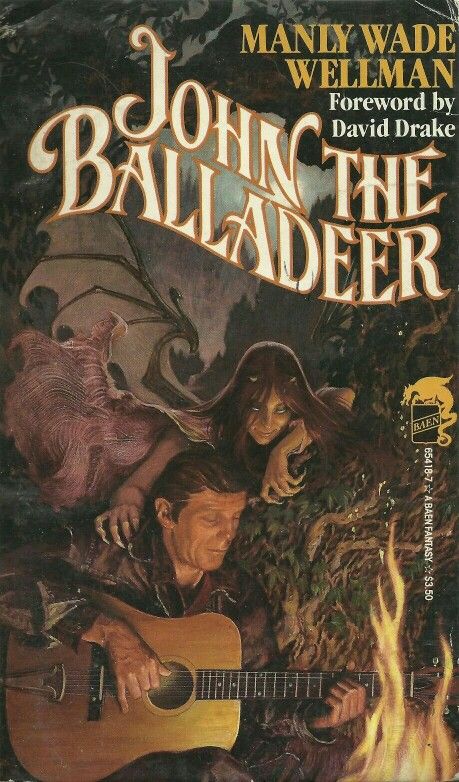
The Far-Flung Literary Webs of Manly Wade Wellman
by Brian Murphy
I’ve always been interested in the great chain of influence, the through-lines from one writer to the next. And I still get a thrill when I discover them, or better yet, experience them in the texts themselves. One of these great through-lines is Manly Wade Wellman (1903-1986). While he does not seem widely read today, the threads of Manly’s life and work are inextricably woven through horror and sword-and-sorcery, from the pulps all the way up to the present day. Even if you haven’t read him, odds are you’ve experienced Wellman in one way or another.
There is a clear literary chain from H.P. Lovecraft to Wellman, on to Karl Edward Wagner and Stephen King. I think it continues in Joe Lansdale, whom Wellman must have influenced, though my somewhat cursory internet research has not turned up anything definitive (Wellman did influence King, who influenced Lansdale). You can see the similarities in the authentic regional voice both use in their stories. Sure, Lansdale is associated with East Texas, and Wellman North Carolina, where he eventually settled in the early 1950s, but the feel is quite similar.
While recently reading a collection of Wellman stories I was pleased to stumble into one of these interesting literary confluences, which I would equate to encountering Unaussprechlichen Kulten in the pages of a James Patterson novel. In the Pines is an old song with a mysterious history. Wikipedia traces its origins to the southern Appalachia region of the 1870s, where it was played by the locals until recorded and popularized by the likes of Lead Belly. I’ve become a fan of the rendition by Nirvana recorded during a 1993 MTV Unplugged performance. The lyrics are haunting, evoking unspoken ill events in deep isolated places, today given further gravitas by our knowledge of Kurt Cobain’s impending death. Wagner drew upon In the Pines for a wonderful short story of the same name, and so did Wellman for his story “Shiver in the Pines,” which I encountered in the collection Who Fears the Devil?
Who Fears the Devil? is a collection of short stories featuring a single protagonist, known simply as John, sometimes Silver John. John is the modern equivalent of a medieval bard, a free-spirited traveler who carries a silver-stringed guitar instead of a sword. He plays for food or coins, and his travels get him mixed up in every scrape imaginable.
The landscapes through which John wanders are unforgettable. Even without the supernatural terrors, the isolation of the backwoods of Appalachia makes them a place you don’t want to be wandering at night, alone:
You don’t get used to that breed of mountain night noises, not even if you’re born and raised there and live and die there. Noises too soft and sneaky to be real whispering voices. Noises like big slow wings, far off and then near, keeping pace with you, sometimes two paws, sometimes four, sometimes many. They stay with you, such noises as that, all the hours you grope the night trail, all the way down to the valley so low, till you’re ready to bless God for the little bitty crumb of light that means a human home, and you ache and pray to get to that home, be it ever so humble, so you can be safe inside with the light.
Although I’ve never walked through the deep piney woods of this region, I now feel like I have.
But there are authentic supernatural terrors a-plenty in this collection, monsters and witches and perhaps even the devil himself. Wellman shows his Lovecraft influence with his use of a monster called the Behinder, a thing so horrible that the narrator can’t describe it in words.
These evil forces are powerful and can often only be bested with silver, which John always seems to have on hand, either in the form of coin or by playing his silver stringed guitar. But the stories aren’t grim and bleak, and in fact, are seasoned with good humor, and occasionally tongue in cheek. Some of the baddies are almost slapstick, the kind of mustache-twirling caricatures whom you love to hate.
I find most of the power of these stories are in their depictions of mood and atmosphere: dark and beautiful landscapes, the smiles of pretty farm girls, regions bled white and scarred by old feuds. Lonely old cabins high up in the woods, with stories to tell, occasionally by their ghostly inhabitants. And in the authentic colloquialisms of the inhabitants of the region, all skillfully rendered by Wellman.
In short, Wellman is good. Karl Edward Wagner famously referred him as “the dean of fantasy writers” and his influence on Wagner is plain. I believe Wagner’s “Two Suns Setting” is a direct homage to Wellman’s “Walk Like a Mountain”. Beyond the fact that both are about encountering literal giants, Wagner dedicated the Kane collection Night Winds to his friend, for whom he wrote:
To Manly Wade Wellman―
Scholar and Gentleman,
Writer and man,
Friend―
It takes a giant to encompass all these qualities;
And we’ll see no more of giants.
This last line is echoed in “Walk Like a Mountain,” when John sings of the departed giant Strap Buckner, “And he walked like a mountain among men, He was good and he was great, and the glorious Lone Star State, Will never look upon his like again.” Rafe Enoch stands eight feet tall, a mountain among men. Like the giant of “Two Suns Setting” Enoch has the blood of the sons of gods in him, but is among the last of a dwindling race. He is not an enemy, but not a friend precisely either, but rather a force of nature, something apart.
Wellman sort of feels that way today, removed, a giant from another age of storytelling. His stories initially appeared in the pulp magazines Astounding Stories, Startling Stories, Strange Stories, and Unknown, followed by now rare and hard-to-obtain editions by Carcosa Press. My copy of Who Fears the Devil? is from the now-defunct imprint Star, which also published quite a bit of horror and even sword-and-sorcery back in the day (1977’s Savage Heroes: Tales of Sorcery and Black Magic, edited by Eric Pendragon).
While these tales are horror, not S&S, they are certainly aligned in spirit with the latter. If pure S&S is your thing, Wellman could and did do blood and thunder. He created the character Kardios, warrior and bard of Atlantis, penning five stories that initially appeared in the likes of the Andrew Offutt-edited Swords Against Darkness. These were recently collected by DMR Books. DMR also recently republished Wellman’s final novel, Cahena, a war epic telling the story of a brave and beautiful warrior queen believed to be a sorceress and prophetess who reigned over the Berbers in the seventh century.
Want to read some Wellman? Carcosa editions are notoriously expensive and hard to obtain. Fortunately several of Wellman’s stories including the iconic collection Worse Things Waiting have been recently reprinted by Shadowridge Press. Or try DMR Books.
Brian Murphy is the author of Flame and Crimson: A History of Sword-and-Sorcery (Pulp Hero Press, 2020). Learn more about his life and work on his website, The Silver Key.










